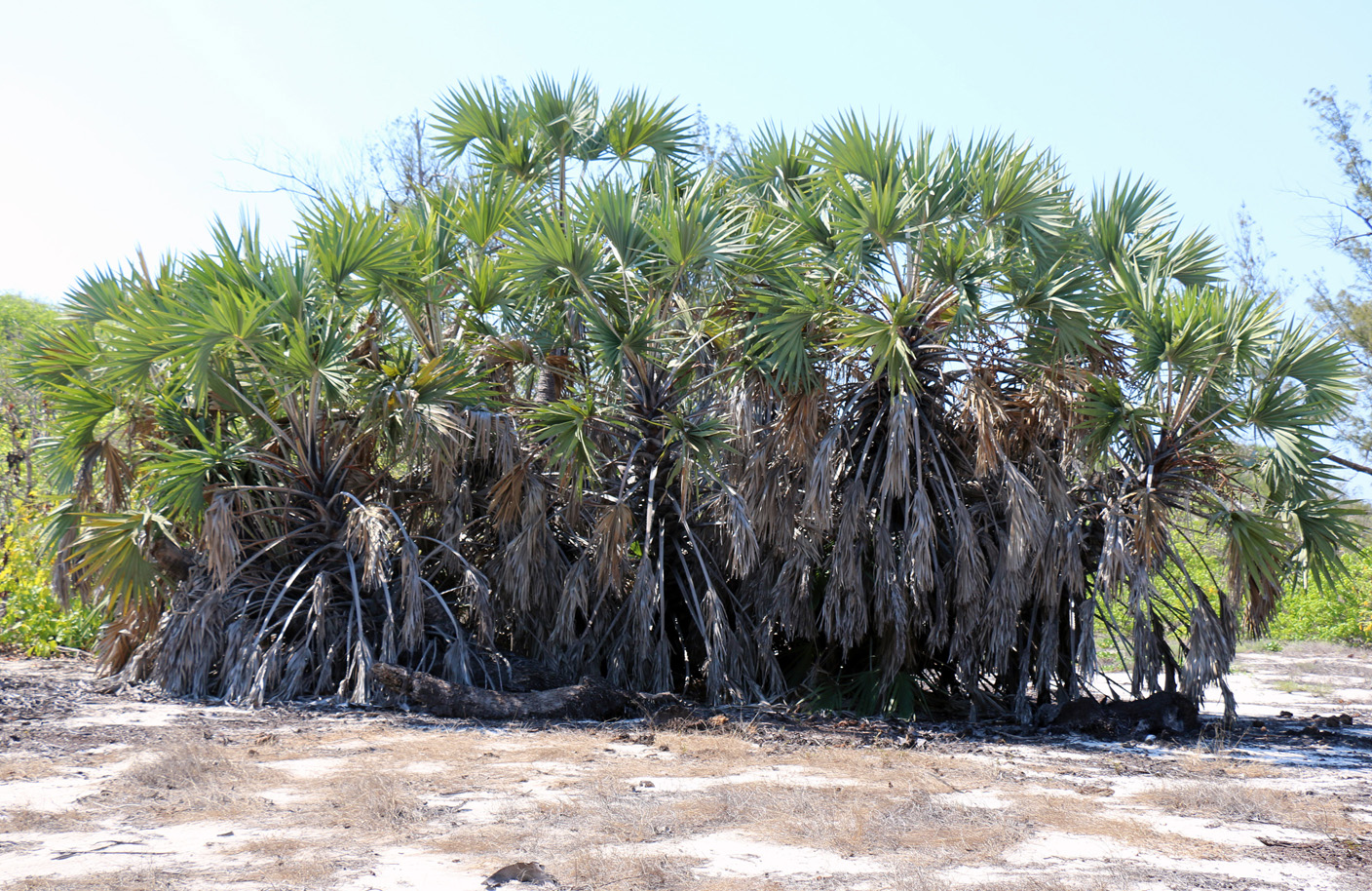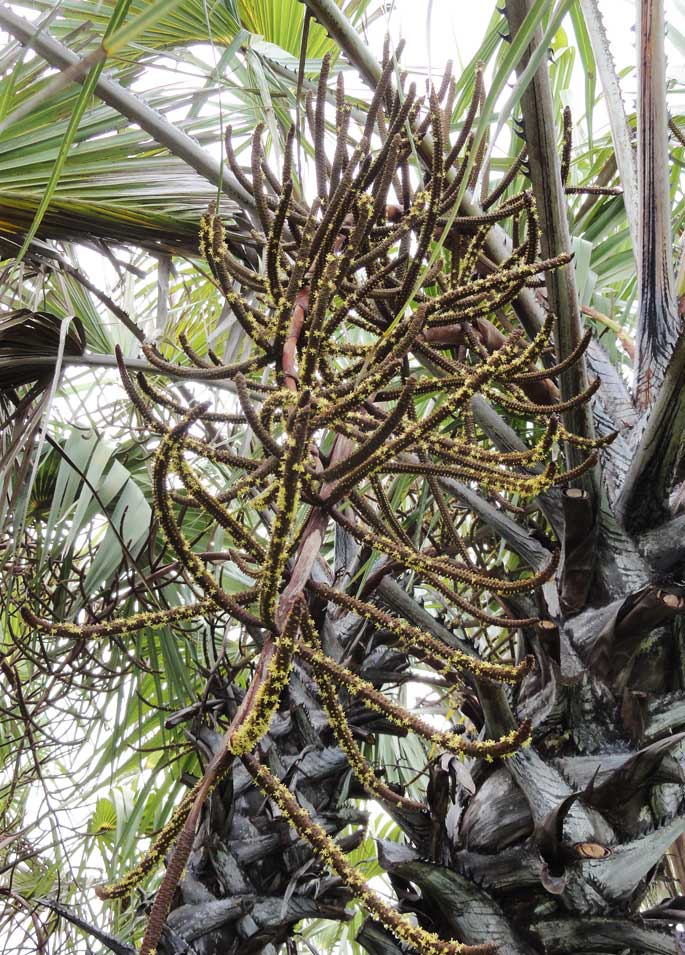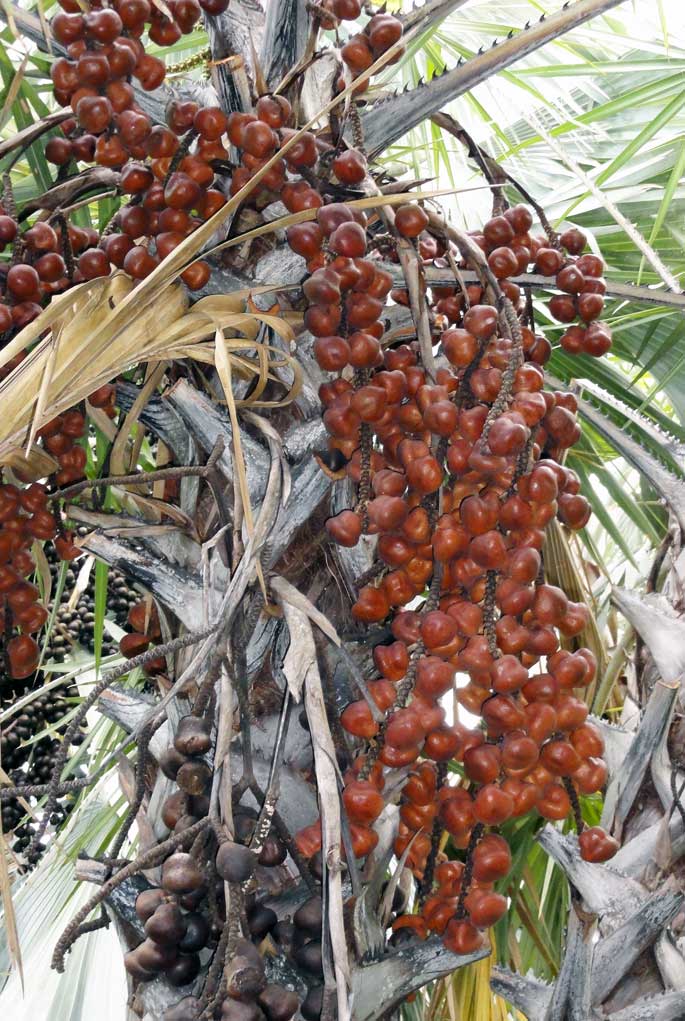Hyphaene coriacea
Hyphaene coriacea Gaertn.; Fl. Trop. E. Africa, Palmae: 29 (1986); Palm. Afr. 25 (1995). -Icon.: Fl.Trop. E. Africa, Palmae: 25, 30, 32 (1986); Palm. Afr. 25, 94, 95, 153 (1995); Fl. Zambes. 13(2): 44, 59 (2010);
Synonyms.: Chamaeriphes coriacea (Gaertn.) Kuntze; C. shatan (Bojer ex Dammer) Kuntze; C. turbinata (H. Wendl.) Kuntze; Corypha africana Lour.; H. baronii Becc.; H. beccariana Furtado; H. coriacea var. minor Drude; H. hildebrandtii Becc.; H. natalensis Kuntze; H. oblonga Becc.; H. parvula Becc.; H. pileata Becc.; H. pleuropoda Becc.; H. pyrifera Becc.; H. pyrifera var. arenicola Becc.; H. pyrifera var. gosciaensis (Becc.) Becc.; H. pyrifera var. margaritensis Becc.; H. shatan Bojer ex Dammer; H. spaerulifera Becc.; H. spaerulifera var. gosciaensis Becc.; H. tetragonoides Furtado; H. turbinata H. Wendl.; H. turbinata var. ansata Becc.; H. wendlandii Dammer
Palms dichotomously branched at the base; frequently 3-5 individuals growing from the same point).
Stem 3-6 m in height, 25-30 cm in diameter, stems often covered by remnant leaf sheaths on the uppermost region.
Leaves 12-15; leaf sheaths 40-45 long, 25 cm wide, with a long longitudinal cleft, armed with spines in the uppermost region, covered with a brown, irregularly spread indumentum; petiole 0,8-1,7 m x 5-10 cm, light green, slightly channeled towards the base, dorsiventrally compressed at mid-length and the apex, covered specially in the abaxial region by the same indumentum observed in the leaf sheath, the spines on the petiole margins inserted every 5-6 cm and becoming closer towards the apex of the petiole, the spines black, upward oriented but in some cases displaying opposite direction in the two sides of the petiole, 1.2 cm long and 0.5 cm wide at the base, hard and woody; costa strongly recurved, 50-100 cm long x 2.7 cm wide at the base, becoming much thinner towards the apex of the leaf blade, covered with an irregularly spread indumentum; hastula more or less asymmetrical, up to 8 cm long; the leaf blade composed of 62-79 segments, olive green, basal segments (45-) 60-70 x 2-3 cm, middle segments, 90-100-110 x 5-8 cm and apical segments 50-65 x 1.5-2,5 cm, the main veins prominent on the abaxial side, inter segment fibers up to 30 cm x 1 mm, brown.
Inflorescences 2-3 on each plant.
Male inflorescence 2-branched; prophyll not seen; peduncle 10-30 x 2-3 cm, dorsoventrally compressed; peduncular bracts at least two, tubular, pointed at the apex 20-22 cm long x 3-4 cm wide, densely covered by a brownish indumentum on the outer side, smooth and striate on the inner side, cartaceous; rachis (40-) 80-90 cm x 2-3 cm, circular to dorsoventrally compressed, completely covered by the peduncular bracts, ending in a fertile, 22 cm long, spicate rachilla first branch rachillae 8, excepting the spicate apicalmost rachilla, all of them further branching at the top; showing a tendency of spiral insertion on the rachis; rachillae bracts 7, one subtending each rachilla; basal rachilla bracts 30-32 cm long, similar to the peduncular bracts; basal rachillae with a sterile part of 22 cm x 1.2 cm, convex abaxially, slightly channeled adaxially, at the top bearing two or most commonly three fertile branches, each one of 20-22 x 1.5 cm, cylindrical, densely covered minute bracts subtending either buds or anthetic flowers; mid-length rachillae with a sterile part of 23 x 1.2 cm, convex abaxially , slightly channeled adaxially, at the top bearing three fertile branches, each one 23 x 1.4 cm, cylindrical, densely covered minute bracts subtending either buds or anthetic flowers; apical rachillae with a sterile part of 18 cm x 0.8 cm, convex abaxially , slightly channeled adaxially,, at the top bearing two fertile branches, or spicate, each one of 22 cm x 1.5 cm, cylindrical, densely covered by minute bracts subtending either buds or anthetic flowers.
Female inflorescence 2-branched; prophyll not seen; peduncle of at least 30 cm; peduncular bracts not seen; rachis 70 cm long, 2,5-3,5 cm wide, circular to dorsiventrally compressed, completely covered by the peduncular bracts, ending in a fertile, spicate rachilla; first branch rachillae 4-12, excepting the 2-3 spikate apical most rachillae, all of them further branching at the top; showing a tendency of alternating insertion on the rachis; rachillae bracts 12, one subtending each rachilla; basal rachilla bracts 30-32 cm long, covered with a brownish, irregularly spread indumentum, basal rachillae with a sterile part of 2 cm x 2 cm, convex abaxially, clearly channeled adaxially, at the top bearing four fertile branches, each one of 33 x 1.2 cm, cylindrical, densely covered minute bracts mid-length rachilla bract of at least 20 cm; rachillae with a sterile part of 24 x 2.1 cm, convex abaxially , clearly chanelled adaxially, at the top bearing five fertile branches, each one 30-32 x 1.1 cm, cylindrical, densely covered minute bracts subtending either buds or anthetic flowers; basal rachilla bract of at least 20 cm, apical rachillae with a sterile part of 18 cm x 0.9 cm, convex abaxially , chanelled adaxially, spicate, fertile part of 20 cm, cylindrical, densely covered by minute bracts subtending either buds or anthetic flowers.
Flowers, male arranged in 10, slightly parallel, spirally oriented rows; specially the region between the base of the petals and the insertion of the stamen filaments looks shiny and apparently nectariferous. Female flowers not yet studied.
Fruits extremely polymorphic in shape and size, to 6-7 cm long and 4 cm wide, pale green when immature, ripening brown-greenish to dark brown (Fig. 3-8).
Hyphaene coriacea grows in coastal lowland regions, especially sand dunes, and rarely extends to inland areas; it is distributed from sea level to 300 m.
At least 23 different names, all of them considered nowadays as synonyms, have been proposed for this palm.
This species is distributed in Kenya and Tanzania, extending to Somalia and southwards to Mozambique and South Africa; also distributed in Madagascar (Dransfield, 2010, Fig. 9).
The name Hyphaene coriacea has been widely misused and often applied to other species (H. compressa). Also, more recent field work has emphasized the plasticity of this species and the gradual continuum in form between the dwarf, coastal dune type to the more erect type (Tuley, 1995).
No uses have been reported for this species.
The conservation status of this species has been recently assessed by Cosiaux et al. (2017) and the category of Least Concern (LC) has been proposed. You can get detailed information on this assessment by clicking in the following link: http://www.iucnredlist.org/details/195994/0

Fig. 1. Hyphaene coriacea grove in the Iles Barren, Nosy Andrano (Madagascar). Photo courtesy of Iacopo Luino.
Fig. 2. These male and female clumps of Hyphaene coriacea were studied in the Montgomery Botanical Center (Miami, USA). The male inflorescence of one of these individuals was collected and studied in the MBC lab. The seeds of these palms were originally collected in Madagascar.
Fig. 3. Male inflorescence at full anthesis. Plant cultivated at the Montgomery Botanical Center (Miami, Florida)
Fig. 4. Detail of male rachillae, note that the flowers present different stages of development and are arranged in vertical rows. Plant cultivated at the Montgomery Botanical Center (Miami, Florida)
Fig. 5. Detail of male rachilla; the flowers are at full anthesis and bud stage and display the six, bright yellow anthers. Note that no pistillode differentiates in the male flowers. Plant cultivated at the Montgomery Botanical Center (Miami, Florida)
Fig. 6. Detail of female rachilla; the flowers are at full anthesis and all of them present more or less the same stage of development. Plant cultivated at the Montgomery Botanical Center (Miami, Florida)
Fig. 7. Impressive infructescence of Hyphaene coriacea. The brown-orange colored fruits present more or less the same stage of development. Note the leaf sheaths remaining on the stem. Plant cultivated at the Montgomery Botanical Center (Miami, Florida).
Fig. 8. Detail of the polymorphic fruits of Hyphaene coriacea. The seeds of this palm were collected in Madagascar by Larry Noblick, head palm researcher at the Montgomery Botanical Center.

Fig. 9. Distribution map of Hyphaene coriacea (based on Stauffer et al., 2014). The species is also present in Madagascar (Dransfield, 2010).







